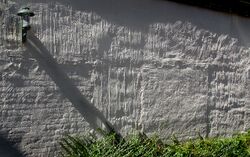Raking light
Raking light, the illumination of objects from a light source at an oblique angle or almost parallel to the surface, provides information on the surface topography and relief of the artefact thus lit. It is widely used in the examination of works of art.
Examination of paintings
Using raking light, the effects of impasto and the surface texture of a painting are accentuated by the increased illumination of surfaces facing the light source and the exaggeration of shadows on surfaces facing away from the light source.[1] In some instances, raking light may help reveal pentimenti (changes in an artist's intention).[2] In the case of wall paintings, raking light helps show preparatory techniques such as incisions in the plaster support.[3]
Conservation
Conservators examine objects under raking light during a visual inspection and for condition recording.[1] In the examination of easel paintings, raking light may help document craquelure, paint cupping, uneven tension in a canvas, or warp in a panel.[4] In the examination of wall paintings, raking light can help document surface deterioration phenomena such as the efflorescence of salts and micro-delamination, and may be used for monitoring the effects of conservation interventions.[5]
See also
- Conservation-restoration
References
- ↑ Jump up to: 1.0 1.1 "Glossary - raking light". The National Gallery. http://www.nationalgallery.org.uk/paintings/glossary/raking-light. Retrieved 8 March 2011.
- ↑ "Raking light and relief". Tate. http://www.tate.org.uk/learn/online-resources/ophelia/conservation-ophelia/raking-light-and-relief. Retrieved 8 March 2011.
- ↑ "The Conservation of Wall Paintings". Getty Conservation Institute. p. 25. http://www.getty.edu/conservation/publications_resources/pdf_publications/pdf/wall_paintings.pdf. Retrieved 8 March 2011.
- ↑ "Lighting techniques - raking light". Hamilton Kerr Institute. 8 March 2011. http://www-hki.fitzmuseum.cam.ac.uk/services/photo_lighting.html.
- ↑ "The Conservation of Wall Paintings". Getty Conservation Institute. pp. 49, 145f. http://www.getty.edu/conservation/publications_resources/pdf_publications/pdf/wall_paintings.pdf. Retrieved 8 March 2011.
 |



